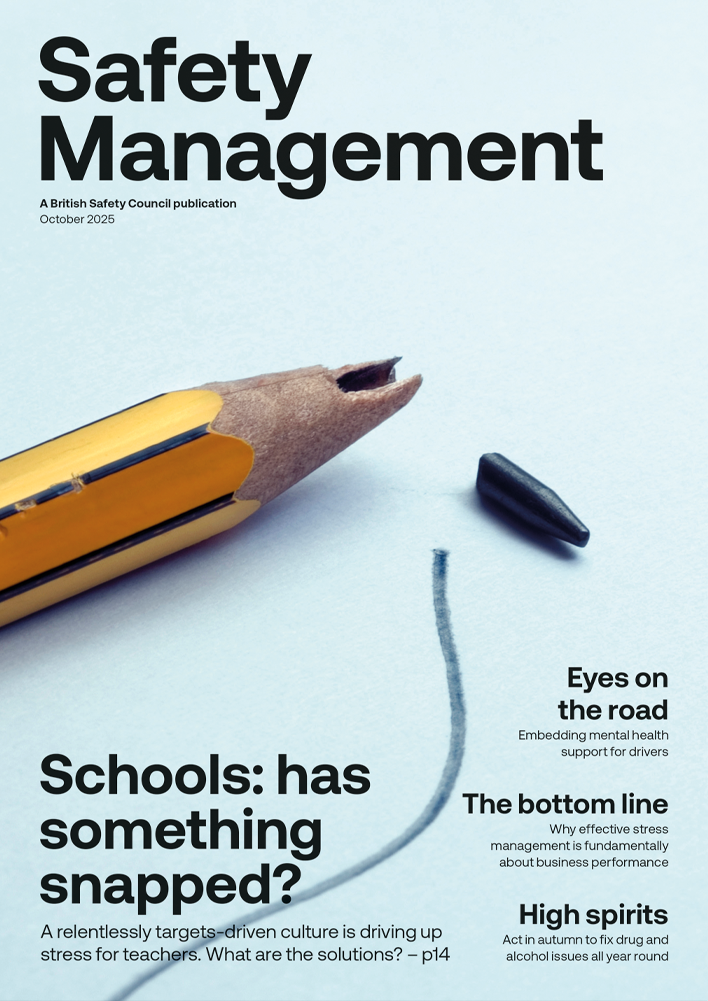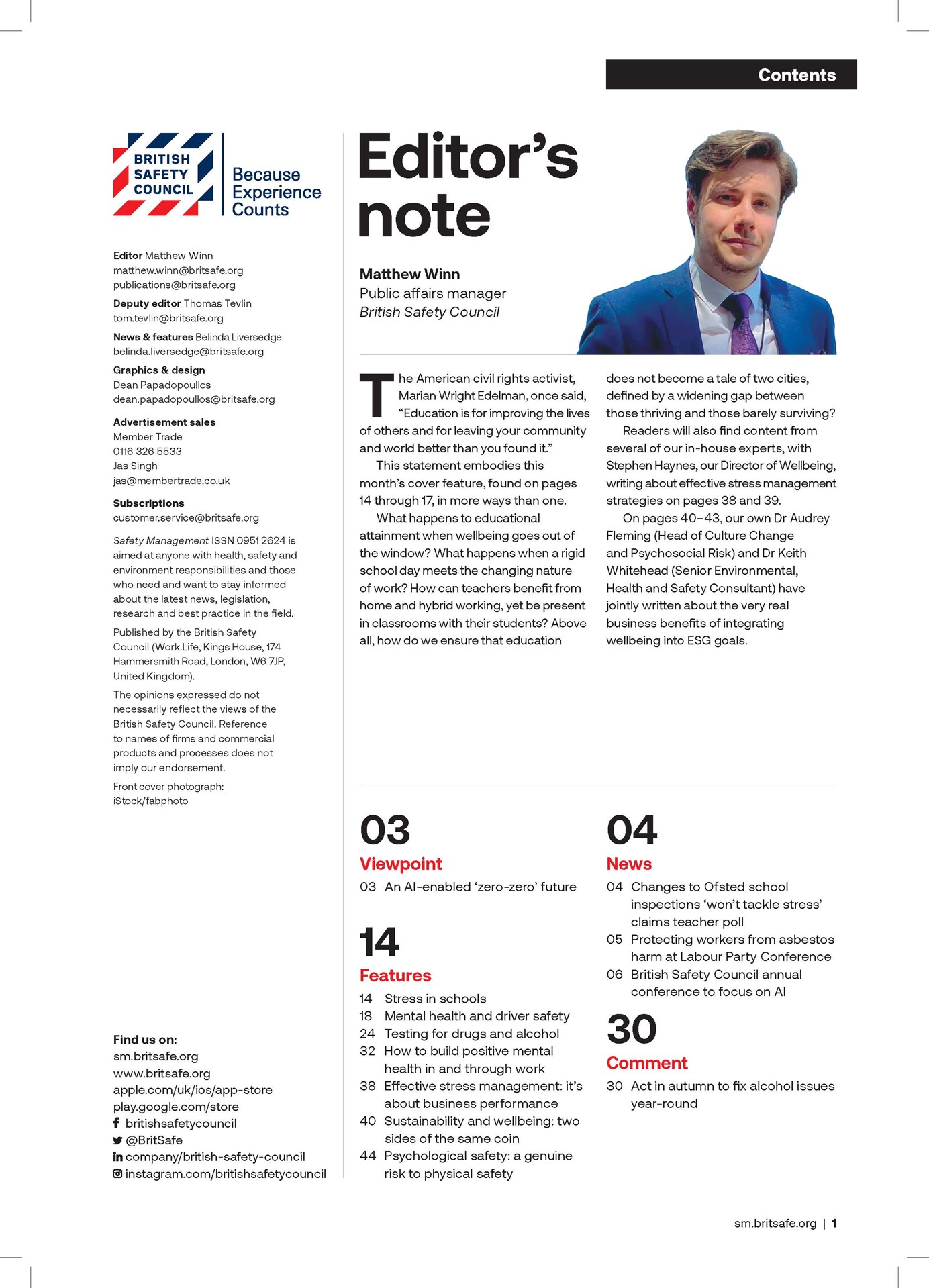Each day across the UK, millions of employees take to the roads as part of their working lives. Whether delivering parcels, attending client meetings or riding bicycles between jobs, road use plays a vital role in keeping businesses going. While the general health and safety landscape has evolved significantly over recent decades, work-related road risk (‘WRRR’) remains an area that is too often overlooked by employers.
Opinion
Work-related road risk – steering clear of danger
The human and financial costs of these risks when things go wrong can be devastating for employees and their families. What’s striking is how many of these incidents are entirely preventable and how often they result from health and safety failures rather than momentary lapses in judgment.
The scale of work-related road risk
WRRR is not a niche concern. According to the Health and Safety Executive (HSE), up to one-third of all road traffic collisions in the UK involve someone who is at work at the time. That equates to thousands of injuries and hundreds of fatalities each year.
Despite this large-scale risk, because these incidents occur on public roads rather than in factories or construction sites, they are frequently underreported and under-prioritised in risk management strategies.
A common misconception is the belief that only professional drivers (for example, HGV or delivery van drivers) fall under the remit of WRRR. In reality, any employee who uses a vehicle for work purposes is exposed to risk - whether in a company car, personal vehicle, delivery bike, or even on foot.
What’s important is not the type of vehicle, but the purpose of the journey. Commuting is generally excluded, but the moment an employee travels between sites, to a client meeting, or for a delivery, whether in a company vehicle or their own, they are driving ‘for work’ and the employer’s duties apply.
 Ben Pepper: "I urge all employers to examine the systems, expectations and cultures that put people in harm’s way on our roads. The legal consequences of getting it wrong can be severe."
Ben Pepper: "I urge all employers to examine the systems, expectations and cultures that put people in harm’s way on our roads. The legal consequences of getting it wrong can be severe."
Employer duties and legal responsibilities
Under the Health and Safety at Work Act 1974, employers have a duty to ensure, as far as is reasonably practicable, the health, safety and welfare of their employees. This extends to work-related driving activities, even though the roads themselves are outside the employer’s direct control.
The Management of Health and Safety at Work Regulations 1999 require employers to carry out suitable and sufficient risk assessments, including for road-related tasks. Guidance from HSE has made it clear that managing occupational road risk should be an integral part of health and safety management.
When employers fail in these duties, they not only face civil liability through personal injury claims but may also be subject to criminal prosecution, especially in the event of a serious or fatal incident.
There are a variety of failings, which could result in road collisions and ultimately successful injury claims against employers:
- Lack of risk assessment – too often, employers do not carry out any formal risk assessment of work-related driving, particularly where staff use their own vehicles. The absence of policies around safe routes, fatigue management or mobile phone use while driving can result in liability.
- Failure to maintain vehicles – where employees drive company-owned vehicles, employers have a duty to ensure those vehicles are roadworthy, regularly maintained, and fit for purpose. Failure to carry out routine checks (such as tyres, brakes and lights) can prove dangerous and even fatal.
- Inadequate training – simply holding a driving licence does not mean an employee is competent to drive for work purposes. Employers should assess whether additional training is needed, especially for vans, e-bikes or scooters, which have specific handling risks.
- Unrealistic schedules – there are situations where drivers are incentivised to take risks. Unrealistic delivery targets or rota patterns can result in speeding, skipping rest breaks or driving while tired. Courts and insurers will look closely at whether the working culture encouraged or ignored unsafe driving behaviour.
- Using mobile devices – despite widespread awareness of the dangers, employees continue to use mobile phones or similar devices while driving, particularly when those devices are used for work. If an employer has not enforced clear policies and disciplinary consequences, they may be liable for the resulting harm.
The hidden risk – grey fleets
One area of growing concern is the so-called ‘grey fleet’. A grey fleet is the title given to personal vehicles that are used by employees for business purposes. It can be cost effective for business to adopt this strategy because there can be clear cost savings when companies are not required to purchase vehicles.
Employers might mistakenly believe they are not responsible for these employee-owned vehicles. In fact, they have the same duty of care as they would with any other company vehicle. This includes checking that the vehicle is insured for business use, is taxed, has an MOT certificate and is in a safe condition.
Failure to properly manage grey fleet risks can leave employers wide open to claims, particularly where they fail to ensure that vehicles are fit for purpose and drivers are fit to drive with a valid licence.
 Most gig economy workers are classed as self-employed. Photograph: iStock
Most gig economy workers are classed as self-employed. Photograph: iStock
The rise of micromobility
The explosion in use of e-bikes and e-scooters, particularly in urban delivery and courier work, has introduced a new layer of complexity for WRRR. These vehicles can be operated by workers on precarious contracts. Otherwise known as gig economy workers, these individuals engage in short-term, flexible, task-based work, often found through online platforms like Uber or Deliveroo.
Most gig economy workers are classed as self-employed. However, a recent landmark Supreme Court case involving Uber has shown that employers cannot entirely divest themselves of responsibility. If there is a degree of control, such as route planning or performance monitoring, there may be liability.
Moreover, the vulnerability of these road users cannot be overstated. Cyclists and e-bike riders are some of the most vulnerable road users, and when collisions happen the consequences can be severe.
How can employers minimise WRRR?
Organisations can minimise WRRR with strong road safety management systems, which are proactive, well documented, and firmly enforced. These systems include:
- Comprehensive driving for work policy, updated regularly and made available to all staff.
- Robust risk assessments covering all types of journeys and vehicles.
Checks on insurance, licences, MOTs and maintenance records, especially for grey fleet vehicles. - Driver training and competence checks, including for cyclists.
Monitoring of driving behaviours, using telematics or journey logs where appropriate. - A culture that prioritises safety over productivity.
Beyond the legal obligations, there are compelling business reasons to properly manage WRRR. These reasons include:
- Reduced collisions and therefore absenteeism
- Lower insurance premiums
- Improved reputation and employee morale
- Compliance with legal obligations
- Avoidance of fines, litigation and regulatory sanctions.
Final comments on WRRR
Work-related road risk is too often treated as a transport issue, when in fact it is a core health and safety concern. The road may be a public space, but the employer’s duties do not end when their staff exit the car park.
As a personal injury lawyer, I urge all employers to examine the systems, expectations and cultures that put people in harm’s way on our roads. The legal consequences of getting it wrong can be severe. More importantly however, the human toll is one you cannot afford to ignore.
Ben Pepper is Senior associate solicitor, Serious Personal Injury Department CL Medilaw
Contact Ben Pepper at: [email protected]
OPINION

How to create a neuroinclusive workplace
By John Robinson, Schofield Sweeney on 09 December 2025
The modern workplace is a diverse environment. Most workforces will be made up of individuals representing the majority of the groups protected under the Equality Act 2010.

Don’t lose autism in the neurodiversity wave – why targeted reform is essential
By Rt Hon Sir Robert Buckland KBE KC on 03 December 2025
Autistic adults have waited too long for meaningful reform. They have shared their experiences and expertise. Now they deserve action, accountability, and transformation.

Inclusion saves lives: embedding equality, diversity and inclusion (EDI) into global occupational safety and health
By Umer Changaiz, CMIOSH on 03 December 2025



